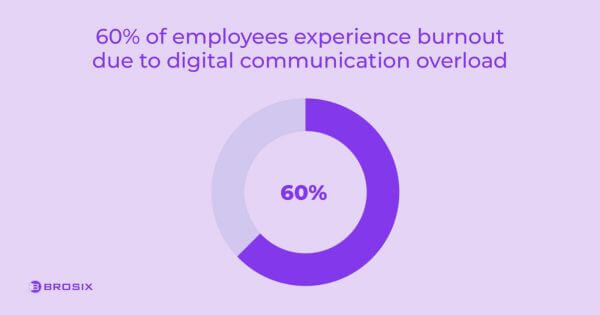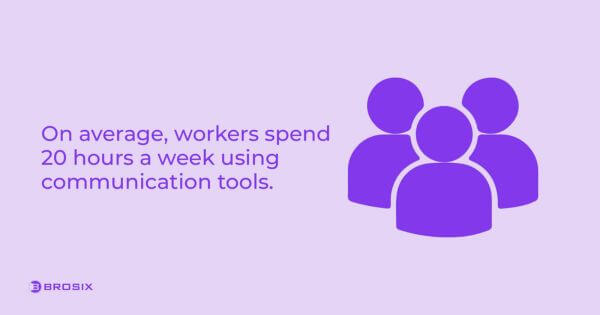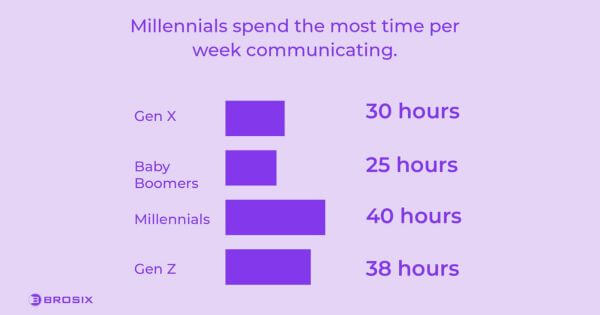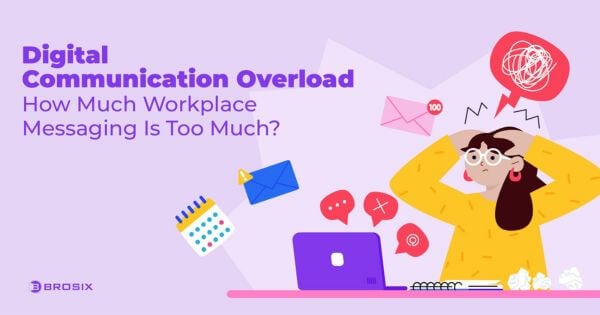Technology helps us work faster and collaborate more effectively. Yet, it can also create challenges. Ironically, the tools meant to streamline our work frequently overwhelm us.
This problem, often dubbed “communication fatigue” or “technostress,” deeply impacts people’s work performance and mental well-being.
In this post, we will cover the latest statistics on what causes digital communication overload and how it impacts people and businesses. We’ll also share science-backed tips on how to overcome these issues and create a more productive atmosphere at work.
Key Findings
- Digital overload has a severe negative impact on employee productivity. Surveys show that 60% of people experience high stress and burnout due to online communication fatigue.
- Remote and hybrid workers are disproportionately affected by this issue. At least 58% of remote employees feel pressured to always be on call.
- 73% of professionals report an increase in the variety of communication channels used over the past 12 months. Knowledge workers say they spend 88% of their workweek communicating across multiple channels.
- The average employee spends 9 hours per week (or about 23% of the workweek) on collaboration tools like email and chat.
- Sectors that are highly reliant on communication apps face the highest rates of technostress. Statistics show that this issue occurs most frequently in finance, tech, IT, and among professional services workers.
What Is Digital Communication Overload?
Digital communication overload occurs when the constant stream of online messages, notifications, and information we engage with becomes overwhelming. This makes it difficult to concentrate, process information, and manage tasks effectively. When the amount of sensory input we receive exceeds our cognitive capacity, productivity takes a nosedive.
In professional environments, particularly among remote workers, digital overload is intensified by the “always-on” culture. This imposes expectations for continuous availability to respond to job-related conversations beyond standard working hours.
Symptoms of digital overload
Cluttered inboxes, elevated stress levels, multiple networking and social apps. This is the reality of our modern-day jobs.
It turns out that our productivity tools are a double-edged sword.
You may not feel it creeping up at first, but digital messaging burnout manifests in various psychological and physical symptoms.
Noel Griffith, the CMO of SupplyGem, has seen the effects of this firsthand:
“I vividly recall a colleague who was technically still in meetings or at their desk from 9 a.m. to 6 p.m. but was so frequently pulled away to respond to Slack messages, emails, and chat pings that they ended up working until 10 p.m. most nights just to complete their actual deliverables. They looked permanently frazzled and frequently complained about never being able to fully disconnect and recharge. It was an unhealthy and unsustainable situation.”
Unfortunately, this is not a singular example. Most commonly, technostress manifests as some of the following symptoms:
- Irritability, heightened stress and anxiety, and a persistent fight-or-flight feeling when yet another notification comes through.
- Mental fatigue caused by the constant influx of messaging and stimuli.
- Overexposure to digital information and communication may also cause emotional numbness and detachment.
- Concentration takes a hit due to constant distractions. Employees may find it hard to focus on tasks if digital messaging constantly interrupts their workflows.
- Excessive screen time may cause physical symptoms such as headaches, strained vision, and disrupted sleep patterns.
- A noticeable drop in productivity is another telltale sign of digital burnout. Overwhelmed employees tend to struggle with completing tasks or fail to meet deadlines.
- Prolonged exposure to information overload without adequate breaks often leads to burnout.
- People who experience several of the above symptoms might develop an aversion to communication. Exhausting work-related interactions may lead to social withdrawal even in one’s personal life.
If left unaddressed, all of these symptoms can severely impact a person’s mental health and professional performance. Prevention is the best way to combat information and communication overload. Recognizing the signs early is a responsibility for both organizations and individuals.
Causes of digital overload
Here’s the uncomfortable truth: unsustainable communication environments are created by people. They’re the ones writing, sending, and receiving all the information flowing around in a company. This, coupled with a lack of training and too many tools, is a recipe for disorganized workflows.
But there are more culprits that cause collaboration bottlenecks at work, namely:
- Always-on culture. Owing to the COVID-19 pandemic, that clear cutoff at the end of the day is gone. The lines between home and work are pretty much blurred now.
- Lack of clear communication boundaries with colleagues.
- Over half of all working-age adults switch between at least three collaboration apps. Using multiple platforms with poor connections or integrations between them lowers productivity.
- On the flip side, poorly managed digital tools can create confusion and inefficiencies, contributing to digital overload.
Statistics About Digital Communication Overload
As we established, mismanaged information flows and constant notifications increase stress and anxiety levels at work. Researchers have examined the impact of communication overload in the modern digital workplace.
We’ve gathered the most up-to-date statistics on digital overload in the workplace.
Let’s take a closer look.
Knowledge workers spend 88% of their workweek communicating.
Digital chatting has become the main job of many workers. According to recent reports, 88% of their week is spent juggling the different ways to communicate.
The average knowledge worker dedicates about 19 hours each week to written messages alone. Add business meetings and calls to the mix, and this leaves people will almost no time for focused work.
Moreover, 55% of employees say they waste too much time figuring out how to reply or interpret written messages. Over the past year, 30% of employees have noticed that communicating with both clients and coworkers has gotten a lot tougher.
Finding the right balance between being productive and staying connected is a huge challenge for digital employees, which only adds to workplace stress.
60% of employees experience burnout due to digital communication overload.

When asked to rate their stress levels on a scale of 1 to 10 in a recent study, 51% of knowledge workers rated it at 7 or higher. Nearly all respondents (97%) reported experiencing some level of work-related nervousness.
Most empirical evidence links too much information with various health issues and also shows that it can lower job satisfaction and employee engagement. For 60% of workers, digital communication is a major contributor to occupational burnout. 53% of surveyed professionals claim to experience anxiety about misinterpreting written messages.
Researchers have also identified a 27.1% increase in negative emotions related to information overload at work. Oftentimes, this stems from the immense pressure people feel to always reply right away.
On average, workers spend 20 hours a week using communication tools.

For the average full-time employee, a normal workweek consists of 40 hours. White-collar workers dedicate the bulk of this time to various writing tasks, such as sending and replying to messages.
Most employees are using digital communication tools for about 20 hours a week. That means half of their time is spent in front of a screen. All this energy lost in dealing with digital clutter is time that could have been used for creative and innovative work instead.
Microsoft’s annual Work Trend Index survey cited inefficient meetings as the number one obstacle to productivity. A whopping 64% of workers say they don’t have enough time or energy to get their work done. When a new notification comes in, it’s just another distraction. This makes them 3.5 times more likely to struggle with thinking of new ideas or thinking strategically.
38% of employees receive too many messages at work.
There is a noticeable gap between how much we are communicating and the efficiency of our correspondence. Excessive notifications result in missed details and misunderstandings.
About 60% of leaders are concerned their teams are not coming up with enough innovative contributions. This lack of breakthrough ideas can be attributed to the time spent—and lost—on multitasking and deciphering a constant influx of digital messages.
Researchers checked in with almost 1,000 workers and found that 38% of them feel overwhelmed by the sheer number of messages they get. Employees are crushed by all the interruptions that disrupt their workflows and reduce productivity.
But it’s not just staff members that feel the negative consequences of too much texting. 59% of business leaders admit to dealing with miscommunication through written messages at least once a week.
Digital communication blurs the work-life boundaries of 58% of remote workers.
In our post-COVID economy, an ever-increasing number of businesses are adopting hybrid and work-from-home (WFH) setups. 45% of remote employees express that digital tools make them feel more connected to their distributed teammates. However, this sense of kinship comes at a cost.
The always-on culture, coupled with the fear of missing out (FoMO), makes it impossible to unplug, even during off hours. Many WFH employees—58% to be exact—feel pressured to be available more often due to the pervasive nature of online communication.
In this case, it’s hard for people to separate work from their personal lives. As Cache Merrill, the Founder, CTO, and CEO of Zibtek puts it:
“High levels of digital communication without clear boundaries often lead to employee dissatisfaction, contributing to increased turnover rates. Employees who feel they are constantly ‘on-call’ or bombarded with requests may seek work elsewhere, where communication is more structured and balanced.”
The finance, banking, and insurance sectors report the highest levels of technostress, reaching up to 59%.
Digital overload occurs more frequently in certain industries. Finance, banking, and insurance employees tend to feel the pinch of technostress the most. These high-pressure sectors rely heavily on communication tools for complex tasks and information exchanges.
These are the business types that most often feel the strain of excessive communication:
| Industry | Percentage affected |
| Banking, finance, insurance | 59% |
| Higher education | 50% |
| Software/IT | 49% |
| Healthcare services | 48% |
| Manufacturing | 48% |
| Utilities | 47% |
Brosix offers a secure instant messaging platform that helps organizations in these sectors stay focused and productive. Reclaim your team’s precious time—try Brosix today!
Millennials spend the most time per week communicating.

If communication overload keeps going unchecked, it will have a detrimental impact on the future of work. This is especially true for the younger generations who are spending more time chatting at work than older generations like Gen X (30 hours) and baby boomers (25 hours).
Millennials (Gen Y) spend an average of 40 hours per week communicating, while Gen Z workers spend 38 hours. In some cases, these figures exceed the typical 40-hour workweek, leaving little room for completing tasks. Regardless of age group, people need a digital detox to avoid overload and boost productivity.
As seasoned employees retire and a new generation—that’s been shaped by the pandemic—comes in, companies need to be ready for change. Acknowledging different opinions regarding corporate responsibility and culture means going for a more flexible approach that meets workers’ needs.
HR, hybrid workers, and large teams face higher levels of communication overload.
Ever since tech tools infiltrated our lives, employees have been expected to be available and responsive at all times. However, the pandemic exasperated this issue as most of our communication moved online.
In some roles, people tend to spend so much time communicating that it spills over the usual time frame allocated for the workweek. This issue disproportionately affects employees in big teams and hybrid setups. For them, work correspondence consumes 42 hours a week.
However, the most impacted group is human resources (HR) professionals. They are clocking in around 47 hours a week in work-related communication.
9 Strategies to Manage Digital Communication Overload
So, what is the biggest roadblock to a healthy collaborative work environment?
Having the right people in the right spots. It’s not just about how much we chat digitally but also how well we do it.
Here are some research-backed best practices you can implement to make a change today:
1. Incorporate AI in workplace communication
Artificial intelligence (AI) has found countless applications in our lives. But did you know it can help alleviate communication burnout, too?
Generative AI tools are particularly handy as writing assistants—72% of professionals already use them for writing-related tasks. And it’s no surprise since most of these tools are text-based and so is the majority of digital communication. You can easily ask an AI tool to summarize a lengthy conversation or rewrite your email using a more professional tone.
On the flip side, there is a significant gap between leaders and workers when it comes to AI adoption rates. Reports show that 89% of business leaders actively use AI tools to communicate, as opposed to only 53% of knowledge workers who do the same.
Despite the potential of AI to streamline communication, over 52% of workers admit they don’t know how to use these tools effectively. Closing this gap will be essential in managing digital tasks and communication going forward.
2. Implement asynchronous communication
About half of all employees think the correspondence they get or communication they carry out during a typical workday actually slows them down.
But guess what? Not everyone is totally against meetings.
About 60% of workers said they feel like they spend “about the right amount of time” in them, as long as they’re actually getting work done the rest of the time. Most people felt that only three out of the last five meetings they were in were worth their time.
Asynchronous formats, like video and audio messages, are starting to replace some meetings, and people are liking that. Structured communication is key for an effective workplace without invasive digital interruptions.
3. Establish boundaries and “do not disturb” periods
Making sure that everyone’s personal time is respected—both during on and off hours—is a must for a healthy collaborative environment.
Setting boundaries has plentiful benefits, especially for productivity. Introducing focus hours into the regular schedule allows people to dive into deep work without distractions. Entering a “flow” state is required for innovative thinking. Set a timeframe, mute all notifications, and tackle complex projects with greater ease.
This applies to after-hours messaging, as well. Some team members might not want to be reached after work unless it’s truly urgent. Emotional boundaries and mutual respect can help keep drama to a minimum, which is fundamental for supportive teamwork.
Here’s how Kamel Ben Yacoub, the CEO of Getuplead, implemented this strategy in his company:
“We agreed on when it’s ok to send messages, how quickly people should respond, and which channels to use for what. We share these rules during our employee onboarding so everyone knows them and things flow much smoother. We have set aside a few hours each day between 11 am to 12 am and 5 pm to 6 pm where everyone agrees to minimize interruptions and really focus on the important stuff.”
4. Promote the right to disconnect
The right to disconnect gives people the ability to set digital limits and not have to deal with job-related emails, calls, or messages after hours. For example, Australia recently introduced a law that protects workers from negative consequences if they do not respond to their employers after work.
France was the first country to acknowledge that labor laws should keep up with how digital communication affects work-life balance. Presently, several countries, mainly in Europe and Latin America, have regulations that recognize the right to disconnect. Many large corporations have similar internal policies, too.
5. Centralize communication by limiting the number of channels
Believe it or not, 84% of business leaders and 70% of knowledge workers have used multiple tools to chat at work this past year. The usual suspects? Email, instant messaging apps, and meetings—these make up about half of the time we spend talking to coworkers each week.
While juggling several channels and switching tabs seems like just a part of the job these days, this shouldn’t be the norm. Each channel adds another slew of notifications, rules, and context, further complicating daily project management. Companies that centralize communication can limit the distractions that come with using too many apps.
With Brosix, you can have your private network up and running in just 60 seconds. Reduce information overload by gaining full control over your organization’s internal messaging. Eliminate unnecessary chatter and keep all of your business communication relevant and secure.
6. Use status indicators to inform colleagues when someone is busy
Being visible online has become a new way to build trust. Status indicators help teams figure out when their coworkers are available so they can reach out at the right moments. Let everyone know if you’re “available,” “busy,” or “do not disturb,” if you need some uninterrupted time.
These little color dots make collaborating so much easier. Most chat applications natively have such a functionality. And if you connect your productivity app to your calendar, the whole process becomes automatic. Your availability stays current without any extra effort on your part.
Here’s what Aaron Whittaker, VP of Demand Generation and Marketing at Thrive Digital Marketing Agency, thinks of status indicators:
We encourage team members to use ‘Do not disturb’ during deep work and ‘Set as away’” for off-hours, resulting in a 30% decrease in context-switching and improved productivity.”
7. Promoting open communication and matching generational expectations
Our reliance on digital tools has opened up new ways for us to connect from afar. That said, we do miss out on some important aspects compared to face-to-face communication. We often lose those subtle non-verbal cues that add so much to our conversations.
Open communication is a crucial piece for solving this puzzle. Employers need to clearly explain what their plans and policies are and how they affect the things that matter most to workers.
Elisa Montanari, Head of Organic Growth at Wrike, recognizes how important this is:
“You want to empower your team to make as many decisions and move as independently as possible but give them the confidence to understand when they should defer to you. Set expectations together about communications so you can find that ‘just enough’ flow. Use work management platforms that offer more visibility so teammates and leaders can see project and task statuses without wasting time on too many back-and-forth messages.”
8. Adding clarity to communication with visuals
In addition to asynchronous communication, using videos and images helps people remember tasks better and makes chatting more effective. According to research, our brains process images about 60,000 times faster than plain text—that’s quite impressive. Visualizing data can significantly decrease cognitive overload and miscommunication at work.
9. Build an employee experience strategy with standard operating procedures
A solid standard operating procedure (SOP) for internal and external communication can make workflows simple and effective. Following established protocols adds clarity and structure to daily activities.
The purpose of the SOP must be defined and shared in a way that meets an organization’s specific needs. Create a checklist of the expectations that must be set in place. The overall goal should be to stay consistent across different channels.
Brandy Hastings, SEO Strategist at SmartSites, recognizes the benefits of clearly outlined work procedures:
“Since we have well-documented SOPs for most tasks, our team knows exactly when communication is required. For example, most discussions happen when tasks are being assigned or during feedback sessions, particularly with new clients. However, because our SOPs are clear, the need for back-and-forth communication is greatly reduced, allowing us to maintain productivity and avoid overwhelming our team with constant messages.”
Putting rules in place to limit after-hours work and communication can help prevent employee burnout. It’s key to check your organization’s guidelines regularly to keep them relevant as things regularly change at work.
Conclusion
Digital communication overload is a prevailing problem for modern businesses. Companies need to set boundaries and pick the right tools to cut down on the noise and make work a better place for management and employees.
Brosix is an all-in-one team chat platform that helps organize workflows, cuts down distractions, and keeps communication on point. With customizable features and secure messaging, Brosix can help your team stay connected without the communication overwhelm.
Take the first step toward reducing digital overload—try Brosix and boost your team’s productivity today!
